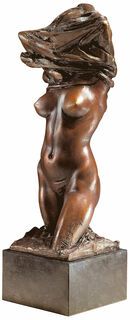Sculpture "Seduzione - The Seduction", bronze
Sculpture "Seduzione - The Seduction", bronze
Quick info
limited, 399 copies | bronze | patinated | total height approx. 53 cm
Detailed description
Sculpture "Seduzione - The Seduction", bronze
Elegance, suppleness, and beauty - are characteristics attributed to Mongini's creative power. The choice of his subjects - mysterious cats or perfect female beauty - already shows what the Milanese considers worthy of veneration and to whom he would like to erect a monument. Typical for the creator of the famous bronze portal of Portofino is the snapshot: he captures beings and figures in mid-motion.
Aphrodite, the goddess of love, who was awarded the prize of the most beautiful in the judgement of Paris, also bears the nickname "The Foamborn": At Mongini, her gifted body seems to emerge from the wet element, like a beckoning siren. When she pulls her robe over her head, it looks like a crown of foam on a wave of passion.
Sculpture in patinated bronze, produced by Lost-Wax-Process. Height incl. pedestal approx. 53 cm. Limited edition of 399 copies worldwide.
About Costanzo Mongini
1918-1981
From his earliest youth, the sculptor and painter Costanzo Mongini, born in Milan in 1918, confidently steered his artistic steps away from the art academies. For him, they seemed to be merely places of exaggerated self-expression. Mongini wanted to preserve his own approach to art and went his way as an autodidact.
Without fumbling experimentation, Mongini grasped what corresponded to his nature: the creation of a volcano-like explosive moment charged with symbolic content, based on the study of the great art of the past and the precise observation of nature. "What calls itself avant-garde today does not interest me," the sculptor freely admitted. Success proved him right: his triumphant bronze church portal in Portofino has become a Mecca for art lovers from all over the world.
Mongini does not see his sculptures as static, but as exalted and intensely provocative. The statue of Cardinal Ottaviani is in the Vatican's private collection.
Exhibitions held in cities like Beirut and Munich brought Mongini worldwide fame. He is especially known and loved by collectors in Italy, Germany, England, Australia, the USA and Japan. The artist died in 1981.
An alloy of copper with other metals (especially with tin) used since ancient times.
When casting bronze, the artist usually applies the lost-wax technique which is dating back more than 5000 years. It's the best, but also the most complex method of producing sculptures.
First, the artist forms a model of his sculpture. It is embedded in a liquid silicone rubber mass. Once the material has solidified, the model is cut out. The liquid wax is poured into the negative mould. After cooling down, the wax cast is removed from the mould, provided with sprues and dipped into ceramic mass. The ceramic mass is hardened in a kiln, whereby the wax flows out (lost mould).
Now we finally have the negative form, into which the 1400° C hot molten bronze is poured. After the bronze had cooled down, the ceramic shell is broken off and the sculpture is revealed.
Now the sprues are removed, the surfaces are polished, patinated and numbered by the artist himself or, to his specifications, by a specialist. Thus, each casting becomes an original work.
For lower-quality bronze castings, the sand casting method is often used which, however, does not achieve the results of a more complex lost-wax technique in terms of surface characteristics and quality.
Collective term for the painters and sculptors of the 20th century, such as Pablo Picasso, Salvador Dalí, Joan Miró, Marc Chagall and others, whose works are the most recognized in our times.
Term for an art object (sculpture, installation), which is produced in multiple copies in a limited and numbered edition according to the artist‘s will.
Artist's multiples have been called the most accessible and affordable art on the market.
A plastic work of sculptural art made of wood, stone, ivory, bronze or other metals.
While sculptures from wood, ivory or stone are made directly from the block of material, in bronze casting a working model is prepared at first. Usually, it is made of clay or other easily mouldable materials.
The prime time of sculpture after the Greek and Roman antiquity was the Renaissance. Impressionism gave a new impulse to the sculptural arts. Contemporary artists such as Jorg Immendorf, Andora, and Markus Lupertz also enriched sculptures with outstanding works.


